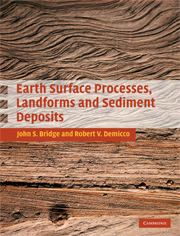Book contents
- Frontmatter
- Contents
- Acknowledgments
- Figure credits
- PART 1 Introduction
- PART 2 Production of sediment at the Earth's surface
- PART 3 Fundamentals of fluid flow, sediment transport, erosion, and deposition
- PART 4 Environments of erosion and deposition
- 13 Rivers, alluvial plains, and fans
- 14 Lakes
- 15 Coasts and shallow seas
- 16 Arid environments
- 17 Glacial and periglacial environments
- 18 Deep seas and oceans
- PART 5 Sediment into rock: diagenesis
- PART 6 Long-term, large-scale processes: mountains and sedimentary basins
- References
- Appendix: Methods of study of Earth surface processes, landforms, and sediments
- Index
- Plate section
18 - Deep seas and oceans
from PART 4 - Environments of erosion and deposition
Published online by Cambridge University Press: 05 June 2012
- Frontmatter
- Contents
- Acknowledgments
- Figure credits
- PART 1 Introduction
- PART 2 Production of sediment at the Earth's surface
- PART 3 Fundamentals of fluid flow, sediment transport, erosion, and deposition
- PART 4 Environments of erosion and deposition
- 13 Rivers, alluvial plains, and fans
- 14 Lakes
- 15 Coasts and shallow seas
- 16 Arid environments
- 17 Glacial and periglacial environments
- 18 Deep seas and oceans
- PART 5 Sediment into rock: diagenesis
- PART 6 Long-term, large-scale processes: mountains and sedimentary basins
- References
- Appendix: Methods of study of Earth surface processes, landforms, and sediments
- Index
- Plate section
Summary
Introduction
The deep sea is defined as water depth greater than 200 m, thereby excluding the continental shelf (Chapter 15). Deep-sea environments are present over 65% of the Earth's surface, and include ocean basins, oceanic trenches, island-arc basins, marginal seas, and downfaulted continental borderlands (Figure 18.1). Although these environments are in different physiographic and tectonic situations, they have certain features in common. There is a continuous supply to the upper parts of the sea of fine-grained organic and inorganic sediment, which settles slowly to the bed (to form pelagic and hemipelagic sediment). Sediment also commonly travels down basin slopes and submarine canyons as sediment gravity flows (turbidity currents, debris flows, and grain flows: Chapter 8) and is spread over submarine fans and basin plains. Water currents due to tides and waves are relatively unimportant, but currents due to wind shear and density contrasts (related to variations in temperature and salinity) are important. These currents are especially significant in moving sediment within the water column and on the bed of deep-sea basins.
Major advances in technology during the latter half of the twentieth century led to revolutionary developments in ocean science, including development of the theories of sea-floor spreading and plate tectonics; acquisition of much more detailed knowledge of ocean-floor geometry and sediment deposits; the realization that sediment gravity flows and deep-sea water currents are responsible for transporting sand and gravel to and around the deep sea, and that these sediment deposits may contain vast quantities of hydrocarbons; great increases in knowledge of oceanic water chemistry, physics, and biology, and how these are linked to the atmosphere and global climate change; and the discovery of new ecosystems associated with mid-ocean-ridge volcanicity and within sediment pore waters.
- Type
- Chapter
- Information
- Earth Surface Processes, Landforms and Sediment Deposits , pp. 630 - 670Publisher: Cambridge University PressPrint publication year: 2008



